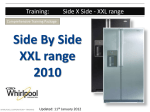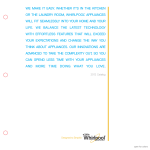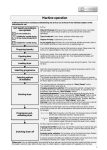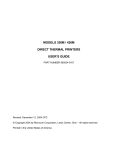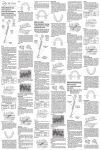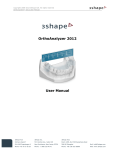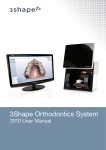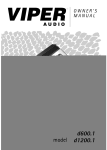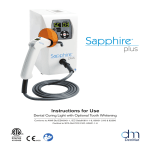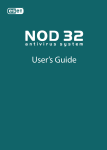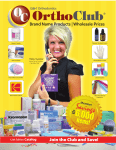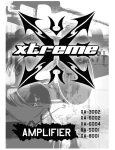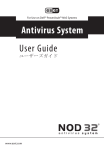Download Troubleshooting the Herbst Appliance
Transcript
Troubleshooting the Herbst Appliance MICHAEL B. ROGERS, DDS T he Herbst* is one of the most popular appliances used today for Class II correction because it is durable and fixed, and therefore does not require special patient cooperation. Although problems are infrequent with the use of today’s improved cements and techniques, any appliance placed in an active oral environment will encounter occasional difficulties. This article will offer guidelines on fabricating the Herbst and troubleshooting problems when they occur. Solution: If the direct method is being used, the orthodontist (not an assistant) should superglue the bands or crowns into the impression for accuracy (Fig. 2). This can be done at the chair before the appliance is disinfected. After the glue has dried, vibrate the impression on low while pouring so that the super-glue bond will not be broken. Tip: A catalyst such as Zip Kicker** or Zap** (available in hobby stores) can be sprayed on the glue to set it up instantly. Potential Problems 1. Distortion of models. Solution: Take accurate impressions; pour alginate impressions immediately, or pour polyvinyl siloxane impressions after 30 minutes. Tip: Wrap an alginate impression in a wet towel while it is waiting to be poured (Fig. 1). 2. Improper placement of bands or crowns in impressions. *Registered trademark of Dentaurum, Inc., 10 Pheasant Run, Newtown, PA 18940. **Pacer Technology, 9420 Santa Anita Ave., Rancho Cucamonga, CA 91730. Fig. 2 Bands super-glued in position in polyvinyl siloxane impression. Fig. 1 Alginate impression wrapped in wet towel while waiting to be poured. 268 Fig. 3 Midline deviation marked on laboratory prescription. © 2002 JCO, Inc. JCO/MAY 2002 p/u 8/01, p.495 Dr. Rogers is an Assistant Clinical Professor, Department of Orthodontics, School of Dentistry, Medical College of Georgia, and in the private practice of orthodontics at 3545 Wheeler Road, Augusta, GA 30909. E-mail: [email protected]. 3. Midline, overjet, and overbite errors. Solution: Obtain an accurate wax bite registration, and mark the laboratory prescription carefully to note the amount of advancement and any midline deviations (Fig. 3). This will reduce chairtime at appliance delivery because the rods and tubes will be cut to the proper length in the lab. If the midline is off at appliance delivery, advancement shims (extenders) can be added to Fig. 4 Shim crimped in place with heavy wire cutter. correct the deviation. The upper tubes may also be replaced to correct the midline as necessary. Tip: The shims should be crimped with a heavy wire cutter*** to prevent them from coming off and possibly being swallowed if the appliance disengages (Fig. 4). 4. Eruption of mandibular bicuspid during appliance fabrication. Solution: Note on the laboratory prescription if a bicuspid will erupt while the Herbst is being fabricated. The lab technician can then allow for the 1/4-1/2mm of eruption by adjusting the rest or crossover wire occlusally (Fig. 5). If this is not done, the Herbst will not seat fully. 5. Loose bands. Solution: Microetch crowns or bands to increase surface area and retention. (This is usually done by the lab.) Microetching will also help the cement adhere to the band instead of the enamel on removal. Tip: A band or crown that is too large or that becomes stretched when loose can be tightened by crimping the gingival margin with a birdbeak plier (Fig. 6). ***Keiba Heavy Cutting Plier, Part No. PU 266, Great Lakes Orthodontics, Ltd., 199 Fire Tower Drive, Tonawanda, NY 14150. Fig. 5 This bicuspid will erupt slightly while Herbst is being fabricated. VOLUME XXXVI NUMBER 5 Fig. 6 Band tightened by crimping gingival margin with birdbeak plier. 269 Troubleshooting the Herbst Appliance Fig. 7 Ceka Bond applied to screw to keep it from unseating. Fig. 9 Archwire covered with plastic tubing to avoid sore spots. Fig. 8 Sore spots from transpalatal arch. Fig. 10 Sore spot from pivot impingement. 6. Cement fractures. Solution: Use a strong cement such as Fuji I.**** Etching the teeth with GC Ortho,**** a 10% polyacrylic acid conditioner, will also improve bond strength. Tip: If an appliance comes off, the cement can be removed by heating it slightly with a Bunsen burner or torch and then dousing it in tap water. The cement will simply flake off. 7. Loose screws. Solution: Apply Ceka Bond† to all screws to prevent them from unscrewing in the mouth (Fig. 7). 8. Inadequate maxillary molar control. Solution: Do not use a transpalatal arch, ****GC America, Inc., 3737 W. 127th St., Alsip, IL 60803. †Preat Corp., Box 1030, Santa Ynez, CA 93460. 270 which can cause sore spots (Fig. 8), facilitate the development of crossbites, and hinder maxillary arch expansion and molar rotation. Without a transpalatal arch, the molars are free to be expanded, moved distally, or rotated as needed for Class II correction. 9. Archwire impinging on the oral mucosa. Solution: Cover the archwire with plastic tubing (Fig. 9) or closed-coil springs to avoid sore spots. If possible, use at least an .018" stainless steel archwire to prevent breakage. 10. Impingement on the ascending rami. Solution: Do not overadvance the mandible to the point that the Herbst pivots impinge on the ascending rami (Fig. 10). In severe cases, it may not be feasible to advance to an edge-to-edge bite at first, and a gradual advancement with shims JCO/MAY 2002 Rogers Fig. 11 Cotton roll attached to appliance with elastic to hold cheek away from pivot. Fig. 13 Larger mushroom screw can be used in any quadrant if sore spot develops. Fig. 14 Broken upper screw head grooved with bur and unscrewed with scaler. Fig. 12 Screws covered with Comfort Caps. (extenders) may be preferable. Tip: Placing the Herbst screw casing in the center or to the mesial of the molar will prevent the screw casing from impinging on the rami. 11. Pivot screw impinging on the cheek. Solution: To hold the cheek away from the pivot, a cotton roll can be attached to the appliance with an elastic tied in a slipknot (Fig. 11). If sore spots develop, the screws can be covered with Comfort Caps‡ (Fig. 12). Since these stay in place for only a few days, it is not advisable to use them on every Herbst case. Mushroom ‡Comfort Solutions, #305 20897 57th Ave., Langley, BC, V3A 8L5 Canada. VOLUME XXXVI NUMBER 5 screws,†† which have a 2mm greater diameter than regular Herbst screws, can also be used to help sore spots heal (Fig. 13). These screws should not be used routinely, however, because the larger heads tend to bind on the rods in lateral movements and thus to break off more often. 12. Broken screw heads. Solution: For a broken upper screw head, remove the band or crown, groove the screw stem with an S.S. White RA-35 slow-speed bur,‡‡ and remove the screw with a scaler or a small jeweler’s screwdriver (Fig. 14). A broken ††5.5mm hex screw, Ormco/“A” Company, 1717 W. Collins Ave., Orange, CA 92867. ‡‡S.S. White, 151 Old New Brunswick Road, Piscataway, NJ 08854. 271 Troubleshooting the Herbst Appliance Fig. 15 Broken lower screw head removed with screwdriver. Fig. 18 Sore spot caused by long rod. Fig. 19 Elastic placed distal to upper pivot and mesial to lower pivot to hold appliance together when patient opens wide. Fig. 16 Wire spot-welded to broken screw stem. 13. Rods coming out of the tubes. Solution: Ensure that the rods and tubes are long enough to prevent the appliance from disengaging in the mouth (Fig. 17). To save chairtime, the laboratory can cut and polish rods to the correct length. 14. Rod impinging on the oral mucosa. Solution: Make sure the rod is not too long. If the rod is causing a sore spot (Fig. 18), it must be shortened even if the appliance comes apart. Fig. 17 Rod cut to correct length. lower screw head can sometimes be unscrewed in the mouth without removing the appliance (Fig. 15). Another option: A wire can be spotwelded to the broken stem and then unscrewed (Fig. 16). 272 15. Bent rods and split tubes. The Herbst will normally come apart occasionally, but rods bend and tubes split when the appliance comes apart frequently. If this occurs, the patient should be seen as soon as possible, because routine disengagement is the primary cause of loose and broken appliances. JCO/MAY 2002 Rogers Fig. 20 When upper primary second molars are used for anchorage, pivots should be moved about 2mm distally to prevent frequent disengagement. Fig. 21 Broken wire and pivot and missing crown. Patient destroyed both crown and banded Herbst appliances. Solution: Make the rods and tubes longer. If the rods cannot be lengthened because they would impinge on the cheeks and the tubes cannot be lengthened because the appliance would be overadvanced, an elastic can be used to help keep the appliance together (Fig. 19). 16. Frequent disengagement when upper primary second molars are used for anchorage. If the upper first permanent molars have not erupted sufficiently for banding, the primary second molars must sometimes be used. Solution: Move the pivots about 2mm distally on the bands or crowns (Fig. 20). Moving the pivots distally VOLUME XXXVI NUMBER 5 allows for longer tubes, which will keep the appliance from coming apart every time the patient opens. 17. Chronic and excessive appliance breakage. Solution: Do not use the Herbst in autistic children, patients with severe bruxism, or extremely uncooperative children (Fig. 21). The Herbst, like all other appliances, requires proper patient selection. 18. Parental misunderstanding about the Herbst phase of treatment. Solution: At the exam and/or consultation 273 Troubleshooting the Herbst Appliance Fig. 22 Signed statement on chart concerning need for second phase of fixed appliance treatment. appointment, explain that the Herbst is correcting the jaw relationship and that the orthopedic phase must be followed by an orthodontic phase to align the teeth. Prevent any misunderstanding about the need for Phase II treatment with full appliances by including an appropriate statement on the patient’s chart and on the contract (Fig. 22). 274 Conclusion The popular Herbst appliance becomes even more efficient when these troubleshooting tips are followed. Knowing what to do in case of a problem helps avoid an emergency atmosphere in the office and allows the orthodontist and staff to gain confidence in incorporating the appliance into their practice routine. ❑ JCO/MAY 2002







